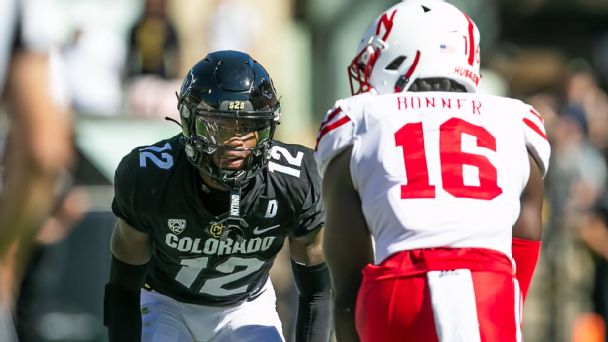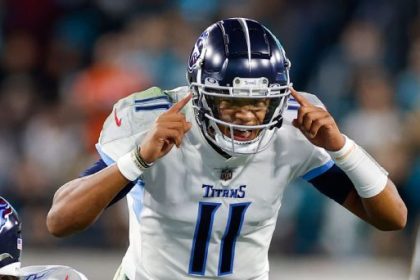
BOULDER, Colo. — When Deion Sanders first laid eyes on Travis Hunter, then one of the most highly touted high school recruits in the country, there wasn’t really a need to evaluate him. It was obvious what he was looking at.
“He’s different, as the young folks say,” Sanders said.
Then the coach at FCS Jackson State, history indicated Sanders had no business recruiting Hunter. The idea that someone of Hunter’s caliber would pass on every college football power — let alone the entire Football Bowl Subdivision — to play at Jackson State could have been easily dismissed out of hand.
But with the confidence that perhaps only comes from being one of the sport’s all-time greats, Sanders recruited Hunter anyway.
“You try to find out what makes him tick, what makes him him, and you recruit to that,” Sanders said. “You’re not gonna find anyone in the country with that talent, but with the thought process of how he goes about life, that’s what you’re trying to identify and go select young men that you can then accompany him on his journey.”
For Hunter, having Sanders on board for his journey outweighed any other factor, and now, after a year together in Jackson, Mississippi, his generational talent is on display for the country to see at the heart of Colorado’s resurgence. Through two games, both wins, Hunter has played a mind-boggling 274 snaps as a starter at cornerback and wide receiver — 129 of 158 (81.6%) on offense, 136 of 142 (95.8%) on defense and nine on special teams — and has joined the Heisman Trophy conversation.
Playing two ways was always part of the plan. Hunter dipped his toes into the offensive waters last season (18 catches, 190 yards, 4 TDs), but he and his coach have been preparing for him to go both ways, full time, ever since.
“I know how to do it. I know how to monitor it. I know how to make sure that you are where you need to be,” Sanders said. “But the rule I have is that you must be dominant on one side of the ball before I allow you to go to the other side. You must be dominant. And I feel as though Travis had proved his dominance.”
If anyone can relate to Hunter, it’s Sanders. And if anyone can put themselves in Sanders’ current shoes, it’s Barry Switzer, who coached Sanders with the Dallas Cowboys from 1995 to 1997, when he often used the former NFL Defensive Player of the Year at receiver.
Other NFL teams weren’t as willing to let Sanders go both ways, Switzer remembers, and Sanders wrote in his book, “Power, Money & Sex, How Success Almost Ruined My Life,” that Dallas’ openness to letting him play offense played a role in his decision to sign.
“He could’ve been an All-Pro receiver,” Switzer told ESPN. “It was just that he was more valuable as a shutdown corner.”
In 1996, Sanders ranked second on the Cowboys in receiving yards (475) behind only Michael Irvin, making him one of the few players in modern NFL history to have a sizable impact on both sides of the ball. The decision to let him do it wasn’t complicated.
“He wanted to play,” Switzer said. “It’s what he wanted to do. He would have taken himself out of the game if he couldn’t do it. He played 100 plays, easily. We counted. He had a couple games where he played over 100 plays.”
Sound familiar? With Hunter, the obvious next question becomes: Is this sustainable? Is it possible to go both ways for the bulk of a college football season and remain effective? There are plenty of skeptics.
“I don’t care how good of shape you’re in, 115 snaps, you can do that now because you’re fresh,” one Power 5 defensive coordinator told ESPN. “But I don’t know how you can sustain [that], especially as I would think some teams are going to try to make him tackle and double him in coverage and that sort of stuff.
“You put in a fourth- or fifth-team wide receiver and say, ‘Look, you block him the whole game. I want him on the bench.’ You literally make him exert himself.”
Comments like this make Sanders roll his eyes.
“You got to understand everybody who’s critical of that in saying, ‘He’s gonna tire, he’s gonna do that,’ shoot they can’t cook and answer the phone at the same time,” Sanders said. “I don’t subscribe to that foolishness because that’s who Travis is. Travis is special. He has a tremendous gift and he wants to play.”
It’s similar to how Owen Marecic felt when Stanford coach Jim Harbaugh told him in the spring of 2010 that in addition to his normal fullback responsibilities — a key position in Stanford’s offense at the time — he would also play middle linebacker. He just wanted to play.
Marecic moonlighted on defense the previous year, but starting on both sides — at such physically demanding positions, no less — was a tall order for a team on the precipice of a breakthrough season. And he loved it.
“I just felt like I was always ready to play rather than coming in and out,” said Marecic, who is a third-year orthopedic resident with Stanford Health. “It was just preferable to me. I actually liked that part of it and, honestly, I didn’t feel all that different after a game in terms of like any physical toll that it was taking [by playing both ways].”
Some players are wired for it, but there haven’t been many. That’s why Hunter has jumped into the Heisman race, an award that rarely gives serious attention to defensive players.
“Because [Heisman voters] want action,” Sanders said. “They want to see plays made and it’s hard to make plays when the play is not designed for you to make it. You gotta be so aggressive and so dominant as a Charles Woodson was. To be able to command that type of attention and make those type of plays where you actually win the Heisman. Just having the audacity to get on the offensive side of the ball and be dominant, that gives [Hunter] the upper hand.
When Woodson won the Heisman Trophy in 1997, he did so as primarily a defensive player, but it’s unlikely he would have won if not for the impact he also made on offense and special teams. Woodson finished that season with 11 catches. Hunter had 11 catches in Colorado’s first game, when he also made a critical interception to help the Buffs upset TCU, last season’s national runner-up.
The best comparison for Hunter might be Champ Bailey, who in his final year at Georgia in 1998 caught 47 passes for 744 yards and made 52 tackles on his way to becoming the No. 7 overall pick in the NFL draft the following spring. Then there was Chris Gamble at Ohio State. He caught 31 passes for 499 yards and was a first-team All-Big Ten selection at cornerback as the Buckeyes won the BCS national championship in 2002.
Others such as UCLA linebacker Myles Jack and Washington linebacker Shaq Thompson have made an impact at running back, but those were both in-season solutions necessitated by circumstances, not the plan going into a season.
With “College GameDay” headed to Boulder this week for the Buffaloes’ game against Colorado State (10 p.m. ET, ESPN), Hunter’s rarified air will be spotlighted even more.
Colorado State coach Jay Norvell can’t help but come away impressed.
“For him to play so many snaps, it’s really a credit to the kid and his competitiveness,” Norvell said. “We’ve got to put pressure on him and we’ve got to do our best with our execution to keep him playing, run him around the field. For him to play as many snaps as he’s done is really a credit to him, and to understand the package and to know everything. You’ve got to give the kid credit for what he’s done so far.
“It’s just a unique situation that they’re doing there. It’s probably opened some people’s minds that guys can do it.”
Adam Rittenberg contributed to this story.










